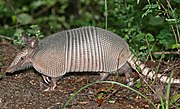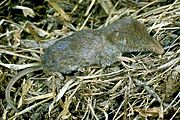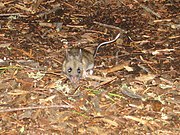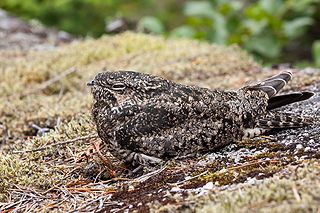Armadillo
| Image | Scientific name | Common name | Family | Conservation concern |
|---|---|---|---|---|
 | Dasypus novemcinctus | nine-banded armadillo common long-nosed armadillo | Dasypodidae | Low |
The U.S. state of Alabama is home to these known indigenous mammal species. [1] Historically, the state's indigenous species included one armadillo species, sixteen bat species, thirteen carnivore species, six insectivore species, one opossum species, four rabbit species, twenty-two rodent species, and three ungulate species. [2] [3] [4] [5] [6] [7] Four of these native species have become extirpated within the state, including the American bison (Bos bison), cougar (Puma concolor), red wolf (Canis rufus), and the elk (Cervus canadensis). [1] [8]
There are six known introduced mammal species in the state. These include the black rat, brown rat, fallow deer, wild boar, house mouse, and nutria. [8]
Human predation and habitat destruction has placed several mammal species at risk of extirpation or extinction. The Alabama Department of Conservation and Natural Resources lists the conservation status of each species within the state with a rank of lowest, low, moderate, high, and highest concern. [3] [5] [6] [7] [8]
| Image | Scientific name | Common name | Family | Conservation concern |
|---|---|---|---|---|
 | Dasypus novemcinctus | nine-banded armadillo common long-nosed armadillo | Dasypodidae | Low |
| Image | Scientific name | Common name | Family | Conservation concern |
|---|---|---|---|---|
 | Canis latrans | coyote | Canidae | Lowest |
 | Canis rufus | red wolf | Canidae | Extirpated |
 | Urocyon cinereoargenteus | gray fox | Canidae | Lowest |
 | Vulpes vulpes | red fox | Canidae | Lowest |
 | Ursus americanus | American black bear | Ursidae | Highest
|
 | Procyon lotor | raccoon | Procyonidae | Lowest |
 | Lontra canadensis | North American river otter | Mustelidae | Low |
 | Neogale frenata | long-tailed weasel | Mustelidae | High |
 | Neogale vison | American mink | Mustelidae | Low |
 | Mephitis mephitis | striped skunk | Mephitidae | Low |
 | Spilogale putorius | eastern spotted skunk | Mephitidae | High |
 | Lynx rufus | bobcat | Felidae | Lowest |
 | Puma concolor | cougar mountain lion panther puma | Felidae | Extirpated |
| Image | Scientific name | Common name | Family | Conservation concern |
|---|---|---|---|---|
 | Blarina brevicauda | northern short-tailed shrew | Soricidae | Moderate |
 | Blarina carolinensis | southern short-tailed shrew | Soricidae | Moderate |
 | Cryptotis parva | North American least shrew | Soricidae | Moderate |
| Sorex hoyi | American pygmy shrew | Soricidae | High | |
 | Sorex longirostris | southeastern shrew | Soricidae | Moderate |
 | Scalopus aquaticus | eastern mole | Talpidae | Low |
| Image | Scientific name | Common name | Family | Conservation concern |
|---|---|---|---|---|
 | Didelphis virginiana | Virginia opossum North American opossum | Didelphidae | Low |
| Image | Scientific name | Common name | Family | Conservation concern |
|---|---|---|---|---|
 | Sylvilagus aquaticus | swamp rabbit | Leporidae | Low |
 | Sylvilagus floridanus | eastern cottontail | Leporidae | Lowest |
 | Sylvilagus obscurus | Appalachian cottontail | Leporidae | High |
 | Sylvilagus palustris | marsh rabbit | Leporidae | High |
| Image | Scientific name | Common name | Family | Conservation concern |
|---|---|---|---|---|
 | Castor canadensis | North American beaver | Castoridae | Lowest |
 | Glaucomys volans | southern flying squirrel | Sciuridae | Lowest |
 | Marmota monax | woodchuck groundhog | Sciuridae | Lowest |
 | Sciurus carolinensis | eastern gray squirrel | Sciuridae | Lowest |
 | Sciurus niger | fox squirrel eastern fox squirrel Bryant's fox squirrel | Sciuridae | Low |
 | Tamias striatus | eastern chipmunk | Sciuridae | Lowest |
 | Geomys pinetis | southeastern pocket gopher | Geomyidae | High |
 | Microtus ochrogaster | prairie vole | Cricetidae | Moderate |
 | Microtus pinetorum | pine vole woodland vole | Cricetidae | Low |
 | Neotoma cinerea | eastern woodrat Florida woodrat | Cricetidae | Moderate |
 | Neotoma magister | Allegheny woodrat | Cricetidae | High |
 | Ochrotomys nuttalli | golden mouse | Cricetidae | Lowest |
 | Ondatra zibethicus | muskrat | Cricetidae | Lowest |
 | Oryzomys palustris | marsh rice rat | Cricetidae | Lowest |
 | Peromyscus gossypinus | cotton mouse | Cricetidae | Lowest |
 | Peromyscus leucopus | white-footed mouse | Cricetidae | Lowest |
 | Peromyscus polionotus | oldfield mouse beach mouse | Cricetidae | Moderate |
 | Peromyscus polionotus ammobates | Alabama beach mouse | Cricetidae | Highest
|
 | Peromyscus polionotus trissyllepsis | Perdido Key beach mouse | Cricetidae | Highest Range limited to the barrier island of Perdido Key in Baldwin County, Alabama and Escambia County, Florida. |
 | Reithrodontomys humulis | eastern harvest mouse | Cricetidae | Moderate |
 | Sigmodon hispidus | hispid cotton rat | Cricetidae | Lowest |
 | Mus musculus | house mouse | Muridae | Introduced |
 | Rattus rattus | black rat | Muridae | Introduced |
 | Rattus norvegicus | Norway rat brown rat | Muridae | Introduced |
 | Zapus hudsonius | meadow jumping mouse | Dipodidae | High |
 | Myocastor coypus | nutria coypu river rat | Myocastoridae | Introduced |
| Image | Scientific name | Common name | Family | Conservation concern |
|---|---|---|---|---|
 | Eubalaena glacialis | North Atlantic right whale | Balaenidae | Critically endangered |
 | Balaenoptera ricei | Rice's whale | Balaenopteridae | Critically endangered |
 | Balaenoptera acutorostrata | common minke whale | Balaenopteridae | Least concern |
 | Balaenoptera borealis | sei whale | Balaenopteridae | Endangered |
 | Balaenoptera brydei | Bryde's whale | Balaenopteridae | Least concern |
 | Balaenoptera musculus | blue whale | Balaenopteridae | Endangered |
 | Balaenoptera physalus | fin whale | Balaenopteridae | Vulnerable |
 | Megaptera novaeangliae | humpback whale | Balaenopteridae | Least concern |
 | Physeter macrocephalus | sperm whale | Physeteridae | Vulnerable |
 | Kogia breviceps | pygmy sperm whale | Kogiidae | Least concern |
 | Kogia sima | dwarf sperm whale | Kogiidae | Least concern |
 | Mesoplodon bidens | Sowerby's beaked whale | Ziphiidae | Least concern |
 | Mesoplodon densirostris | Blainville's beaked whale | Ziphiidae | Least concern |
 | Mesoplodon europaeus | Gervais' beaked whale | Ziphiidae | Least concern |
 | Peponocephala electra | melon-headed whale | Ziphiidae | Least concern |
 | Ziphius cavirostris | Cuvier's beaked whale | Ziphiidae | Least concern |
 | Feresa attenuata | pygmy killer Whale | Delphinidae | Least concern |
 | Globicephala macrorhynchus | short-finned pilot whale | Delphinidae | Least concern |
 | Grampus griseus | Risso's dolphin | Delphinidae | Least concern |
 | Lagenodelphis hosei | Fraser's dolphin | Delphinidae | Least concern |
 | Orcinus orca | killer whale | Delphinidae | Data deficient |
 | Pseudorca crassidens | false killer Whale | Delphinidae | Near threatened |
 | Stenella frontalis | Atlantic spotted dolphin | Delphinidae | Least concern |
 | Stenella coeruleoalba | striped dolphin | Delphinidae | Least concern |
 | Stenella attenuata | pantropical spotted dolphin | Delphinidae | Least concern |
 | Stenella longirostris | spinner dolphin | Delphinidae | Least concern |
 | Stenella clymene | Clymene dolphin | Delphinidae | Least concern |
 | Steno bredanensis | rough-toothed dolphin | Delphinidae | Least concern |
 | Tursiops truncatus | common bottlenose dolphin | Delphinidae | Least concern |
| Image | Scientific name | Common name | Family | Conservation concern |
|---|---|---|---|---|
 | Bison bison | American bison American buffalo | Bovidae | Extirpated |
 | Cervus canadensis | elk | Cervidae | Extirpated; reintroduction in 1920s failed [9] |
 | Dama dama | fallow deer | Cervidae | Introduced |
 | Odocoileus virginianus | white-tailed deer Virginia deer | Cervidae | Lowest |
 | Sus scrofa | wild boar | Suidae | Introduced |

This article seeks to serve as a field-guide, central repository, and listing for the flora and fauna of the US state of North Carolina and surrounding territories.

The Allegheny woodrat, is a species of "pack rat" in the genus Neotoma. Once believed to be a subspecies of the eastern woodrat, extensive DNA analysis has proven it to be a distinct species.

The natural history of Minnesota covers many plant and animal species in the U.S. state of Minnesota. The continental climate and location of Minnesota at the physiographic intersection of the Laurentian and the Interior Plains influences its plant and animal life. Three of North America's biomes converge in Minnesota: prairie grasslands in the southwestern and western parts of the state, the eastern temperate deciduous forests in the east-central and the southeast, and the coniferous forest in the north-central and northeast.

The Fauna of Saskatchewan include several diverse land and aquatic animal species. From the multiplicity of invertebrates and vertebrates, two have been chosen as symbols of Saskatchewan. Cenozoic vertebrate fossils reveal the geological evolution of the interior plains and its prehistoric biogeography. Today, Saskatchewan's ecosystems range from the sub-arctic tundra of the Canadian Shield in north Saskatchewan to aspen parkland, the Mid-Continental Canadian forests in the centre of the province and grassland prairie. Fauna inhabit areas unique to their own specific and varied breeding, foraging and nesting requirements. With a large land and water area, and small population density, the ecoregions of Saskatchewan provide important habitat for many animals, both endangered and not. Naturalists observing wildlife have enumerated shrinking and growing wildlife populations. They advocate programs and methods to preserve or re-introduce endangered species and identify programs of control for outbreaks of wildlife populations. A broad diversity of wildlife habitats are preserved as parks and reserves protecting the feeding and breeding grounds of protected and indigenous fauna of Saskatchewan.

The West Virginia State Wildlife Center is a zoological park in French Creek, West Virginia. Operated by the West Virginia Division of Natural Resources, the Wildlife Center displays many of West Virginia's wildlife, including both native and introduced species. A few of the animals at the Wildlife Center were once found naturally in West Virginia, but were extirpated by the early 1900s.

The fauna of the State of Oregon includes a wide array of species.